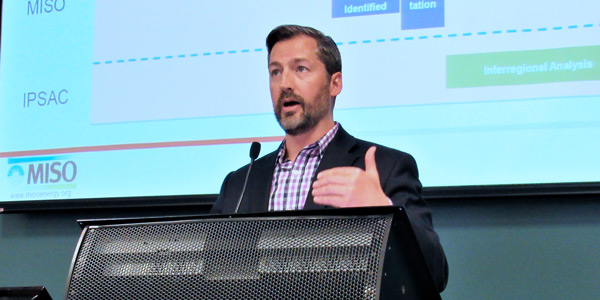By Amanda Durish Cook
MISO and PJM are evaluating eight proposed interregional market efficiency projects, but a supplemental project by American Electric Power could undermine most of the proposals.
MISO and PJM received three upgrade and five greenfield proposals for three congested flowgates ranging from $1 million to $198 million.
Proposals were due at the end of February on interregional projects for constraints MISO and PJM previously identified. (See “2017 MEP Identification Underway,” FERC Signals Bulk of NIPSCO Order Work Complete.)
MISO and PJM will evaluate the proposals’ benefits based on the first 15 years of service, benefit-cost ratios and the cost split between RTOs, Eric Thoms, MISO manager of planning coordination, said at a May 23 Joint and Common Market meeting. AEP-Exelon, NextEra, Northern Indiana Public Service Co., AEP-NIPSCO, WPPI Energy and Northeast Transmission Development submitted proposals, most offering 138-kV projects and a few submitting 345-kV solutions.
All but two of the project proposals focus on the Olive–Bosserman constraint near the western Indiana-Michigan border. Transource Energy also submitted an interregional proposal to correct congestion along the southern Indiana-Ohio border with a new 138/345-kV substation and lines, and NIPSCO presented a new 138-kV line proposal to relieve congestion along the northern Illinois-Indiana border.
Complicating matters, AEP also announced plans for a supplemental project — a project type funded wholly by the transmission owner and therefore not requiring PJM approval — that diminishes the severity of the Olive–Bosserman constraint.
AEP would increase voltage and reroute nearby PJM circuits dating back to the 1930s, with two new 138/120-kV distribution stations to replace lower-voltage stations. The project is still in conceptual stages, AEP said.
PJM staff said the AEP project would relieve some of the congestion on Olive–Bosserman but that the interregional proposals could still provide benefits. MISO and PJM have yet to study the effects of the supplemental project on the six interregional proposals.
At a May 26 Interregional Planning Stakeholder Advisory Committee conference call, NIPSCO’s Miles Taylor asked if the supplemental project would be included in the RTOs’ evaluations of the interregional proposals. PJM interregional planning manager Chuck Liebold said PJM will put the project into a base case scenario if AEP decides to pursue the project. Stakeholders reminded RTO staff at the meeting that developers spent a lot of time and money on the interregional proposals, expressing concern that they could be negated by AEP’s project.
“This [supplemental] project is happening to get attention now because of its impact on interregional projects. We get many, many supplemental projects all the time,” said Liebold, adding that RTO staff has no control over which are built.
The RTOs hope to have preliminary benefit numbers on the interregional projects by the end of June.
Project evaluation will continue for each RTO individually and in the IPSAC through the end of September. Selection of the interregional projects is expected to begin in the fall.
Thoms said that if any projects arise out of the two-year interregional process, they will be sent before the RTOs’ boards for approval by December.
Meanwhile, MISO has asked FERC for an 18-month extension to settle on an internal cost allocation approach under the commission’s directive last year that the RTO allow interregional market efficiency projects as low as 100 kV (ER16-1969). Stemming from a 2013 NIPSCO complaint, FERC’s order also directed MISO to remove its $5 million cost floor for interregional projects with PJM. (See FERC Signals Bulk of NIPSCO Order Work Complete.)




